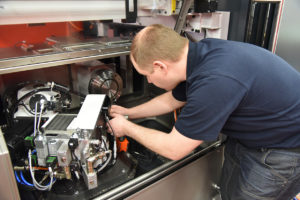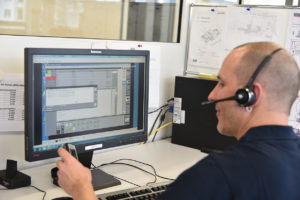This ‘Here and Now’ of the industrial production is strongly influenced by the subject Industry 4.0. But – what exactly is the story behind this term? From our point of view, what we are talking about is quite generally a bunch of convergent technologies all striving towards one common goal: to massively boost productivity in production. Or in other words, to maximize the utilization rate of the individual machines as well as of the entire machine park. Here, networking plays a central role, or to be more precise: intelligent networking. This is why we have bundled our related activities and solutions under the title «Smart Connectivity».
We asked ourselves – what would speak against making the appropriate data available to our custo mers so that they always know the current status and condition of their machines including their subsystems? The answer is simple and plain: nothing. The required technical prerequisites were there. The result: Customers investing in an Agathon grinding machine of the latest models Leo, Dom and Evo are offered two optional interfaces: one Basic and one Advanced type. The Advanced Interface allows for accessing up to 300 data elements.
mers so that they always know the current status and condition of their machines including their subsystems? The answer is simple and plain: nothing. The required technical prerequisites were there. The result: Customers investing in an Agathon grinding machine of the latest models Leo, Dom and Evo are offered two optional interfaces: one Basic and one Advanced type. The Advanced Interface allows for accessing up to 300 data elements.
The data made available spring from the most varied areas of the control architecture. They include simple and at the same time important information, like for instance the fact whether all doors are closed and whether components function properly. You will also receive information for determining the productivity and thus for the statistical evaluation of the fluctuations over a defined period of time. Also production data are made available: Which job is next? Which programs and tools have been set up? The spectrum is broad.
The data are read out via an OPC UA interface. OPC UA is a safe and open standard which – and of that we are convinced – will prevail on the market worldwide. Safety is granted by encryption and a certificate management already provided in the standard. In this connection ‘open’ means that the interface is open to all types of hardware and operating systems. In our view, openness is the central element to conduct a holistic plant management.
Now, what we have is a machine which tells us what we would like to know. Plus, we have an interface through which communication with the machine is realized. But – what do I do now with the newly received information? Naturally, this strongly depends on the actual and specific circumstances prevailing at the individual customer. Whether he owns one or one hundred machines, plays an important role in the usability of the information. Therefore, we thought it necessary to not only enable our customers to obtain machine data but to also offer them the instruments required for effectively analyzing those data. Together with our partner bfa solutions, we offer a Manufacturing Execution System (MES) as further option which is already being used by a lot of companies and which has continuously been optimized over a period of ten years. The MES
solution called PiSolutions is compatible with all common ERP systems and also scales perfectly.
Which means that we are able  to select our OPC UA interface depending on the customer’s requirements (Basic or Advanced). In this way, we dispose of an evaluation tool which may perfectly be tailored to the selected configuration.
to select our OPC UA interface depending on the customer’s requirements (Basic or Advanced). In this way, we dispose of an evaluation tool which may perfectly be tailored to the selected configuration.
If a customer disposes of a manageable machine park, we offer a solution which only reads out and evaluates essential data, i.e. data which are really useful for the customer. These companies may also invest in a basic server solution already offering a
broad spectrum of options as regards data evaluation and reporting. The customer may for instance determine the Overall Equipment Effectiveness and – based on these findings – the need for action in continuous process improvement. The effects of the corrective actions may also be monitored and traced. From our point of view, this is an excellent starter kit for companies which wish to gain solid insight into their production.
On the other side, there are companies with a large and heterogeneous machine park. If those companies raise their production even in the parts per thousand range, this mostly means a significant increase in productivity of the entire machine park. In such cases, our interface provides in-depth information, so that the customer is able to carry out comprehensive statistical analyses. Of course, our interface is open for all analysis instruments the customer is already using.
The more processes may be integrated in the Plant Management, the higher the benefit. Let us take a look at the manufacture of indexable inserts. Grinding the geometry is a central process there. If one succeeds in maximizing the productivity of a single Agathon machine using data acquisition and evaluation, it is a start. If one succeeds in maximizing the accumulated productivity of all grinding machines using data based Plant Management, the benefit is significantly higher. If one even succeeds in also integrating the machines of the upstream and downstream processes, like sintering, coating, cleaning, into the Plant Management, the benefit is 100%.
This is the reason why our interface is open. A customer who invests in an Agathon machine for the first time and already using an existing MES is thus able to smoothly integrate his new machine into the Plant Management. On the other hand, the interface offered by us plus the MES solution PiSolutions is open for the machines of other providers.
Finally, we would like to discuss a further aspect of «Smart Connectivity», namely preventive maintenance and teleservice. «If I only had known earlier». Whoever invests in an Agathon machine with OPC UA interface may safely delete this phrase from his linguistic usage – at least in matters of grinding processes. A scheduled service assignment at a machine is usually faster and less expensive than an unplanned one. Agathon offer their customers teleservice. This means that a service technician has access to the user interface and also to more in-depth areas of the system architecture after access has been cleared by the customer. In four out of five service requests, the problem may be diagnosed immediately, so that the machine operator may take the required actions by himself at the site and under the guidance of the technician. In all other cases, the problem will be solved by a short and well planned field service assignment. At any rate, the customer may increase his productivity thanks to the teleservice.



